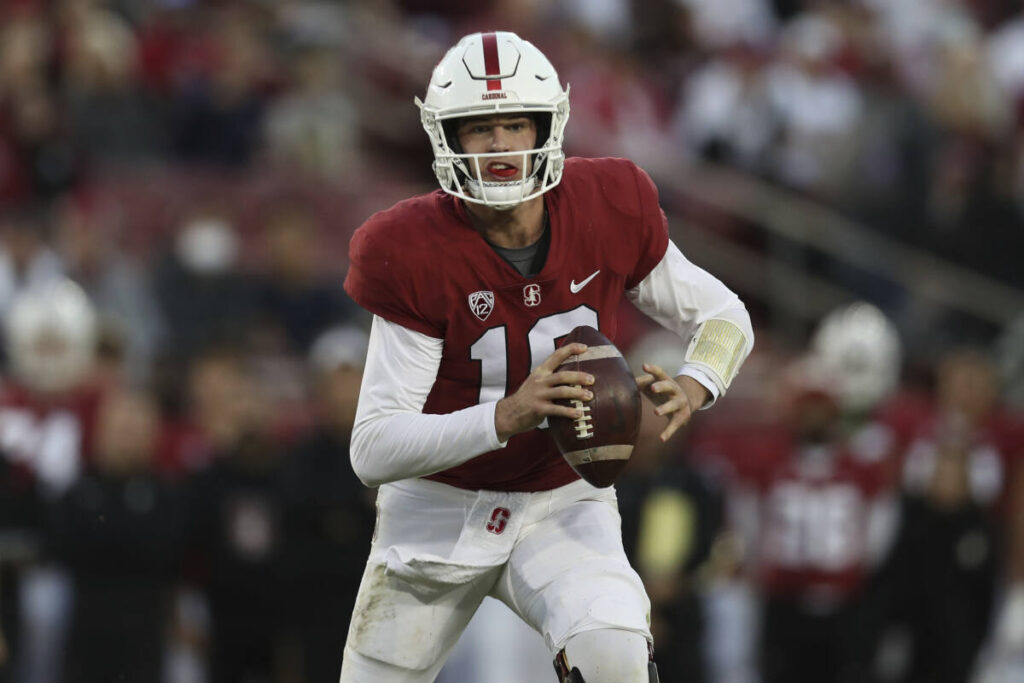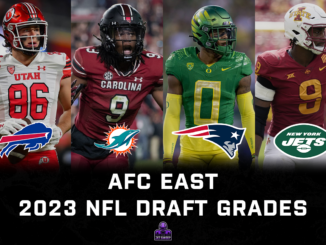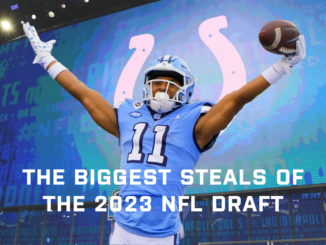The NFL Draft never quite turns out the way we expect it to. As is often the case, there are several notable names still left on the board as we enter Day 3. Here are my top remaining players in the 2023 NFL Draft.
Dawand Jones – OT, Ohio State (6-8, 374, Senior)

Pros: Jones possesses truly generational size, ranking in the 97th percentile or above in height, weight, arm length, wingspan, and hand size. His power profile is predictably exceptional and he is able to uproot defenders in the running game with ease. He pairs this power with a tenacious playstyle and is aggressive in finishing his blocks and getting his opponents on the deck. Jones is like a block of granite as a pass protector and is almost invulnerable to bull rushes. He is a surprisingly smooth mover for his size too.
Cons: Whilst Jones’ size is his biggest strength, it can also be one of his biggest weaknesses. He has a noticeable tightness in his lower half that presents problems when he is asked to redirect laterally. Quicker and more twitched up edge rushers will give him a problem for this reason. Jones’ height also causes issues with his pad level and he is routinely out-leveraged by opponents. He is still too reliant on a two-hand punch and needs to clean up his technique, with 16 penalties in two years as a starter.
Clark Phillips – CB, Utah (5-9, 184, Junior)

Pros: Phillips is a twitched up and explosive athlete and that should translate very well to the NFL level. This allowed him to be very effective in man coverage, where he showcased the fluid hips and quick footwork to mirror. Phillips allowed a passer rating of just 53.4 in single coverage in 2022. Despite not being the biggest cornerback, he is also very good at the catch point, with 23 career forced incompletions. Phillips also plays the game with tremendous toughness that belies his size.
Cons: By far the biggest worry with Phillips is his size. He is diminutive by positional standards, ranking in just the fourth percentile in terms of his weight. He also has a noticeable lack of length, with arms that rank in the first percentile. Although he played primarily as a boundary cornerback in college, Phillips might be forced to move inside to the slot at the NFL level. His lacklustre length also limits his tackle radius and he struggled to wrap up consistently when coming downhill.
Christopher Smith, Georgia (5-11, 192, rs-Senior)

Pros: Smith is a smooth and fluid athlete born to play safety. He is a very smart player who trusts his instincts and possesses a lightning fast trigger. This allows him to play far faster than his physical tools might suggest and it also saw him make plenty of plays at the catch point. Smith forced an incompletion on an incredible 18% of his career targets at Georgia. He is also a considered and effective run defender who takes good pursuit angles from deep.
Cons: Smith lacks ideal long speed and this limits his ability to consistently hold up in man coverage. He can also stand to improve his technique when working from the slot as he will get caught flat footed at the top of routes, allowing receivers far too much separation. Smith has a frustrating tendency to stop his feet on contact, which limits his ability to consistently wrap up in one-on-one situations. He is also a little smaller than you would ideally like an NFL safety to be.
Antonio Johnson, Texas A&M (6-2, 198, Junior)

Pros: It is immediately apparent when you turn on the tape that Johnson is a very smart and cerebral safety. He reads both the run and the pass very well and trusts his instincts to trigger quickly. He pairs this with some solid athletic traits, with fluid hips and good long speed. This allowed him to be utilised both in man coverage and as zone defender from the slot. Johnson is also a physical and willing run defender who packs a real punch on contact.
Cons: Johnson lacks the ball production that you ideally want in a safety prospect. In his three seasons with Texas A&M he was targeted 106 times in coverage and had just one interception and one pass breakup. Johnson played primarily as a nickel back but when he was asked to work from deep he struggled to consistently play with good pursuit angles. He also has a noticeably thin frame for a safety who spends most of his time near the line of scrimmage.
Tanner McKee – QB, Stanford (6-6, 231, Junior)

Pros: McKee is a smart and cerebral passer. He is quick to decipher coverages and locate favourable matchups, whilst also showing the ability to manipulate defenders with his eyes. He is a competent decision maker who rarely puts the ball in harm’s way. His 1.5% turnover-worthy play rate was the seventh best figure in the FBS last season. He is very effective as a quick game thrower, but also has enough arm strength to test defenses over the top.
Cons: McKee is more of a traditional pocket passer and doesn’t offer much in terms of mobility. He won’t be a threat as a designed runner and his play extension capacity is limited. This saw him log a 27% pressure-to-sack rate, which is amongst the worst in the class. He has a long and winding release with a tonne of wasted motion and his footwork in the pocket is often heavy. He struggles when not throwing from a consistent base.
Luke Wypler – IOL, Ohio State (6-3, 303, rs-Sophomore)

Pros: Wypler is an incredibly smooth athlete who displays impressive short area quickness. This makes him a real asset as a zone blocker where he looks excellent climbing to the second level to wall off linebackers. He has also shown the ability to be used effectively as a puller on gap scheme concepts. Wypler’s hand placement is very good for such a young player and he is able latch and steer effectively. He is reliable in pass protection too, allowing one sack in two seasons as a starter.
Cons: Wypler lacks ideal size for an interior lineman. He has a slight frame that clearly causes issues when he is faced with power rushers. You don’t really see much in the way of anchor ability on tape, and that is likely to be even more of a concern at the next level when he is facing NFL competition. There will also be concerns surrounding his length. Wypler has 31.6″ arms, which rank in just the 11th percentile amongst centers. He has also played exclusively as a center in college.
Adetomiwa Adebawore, Northwestern (6-2, 282, Senior)

Pros: Adebawore possesses a truly rare blend of size and speed. At 282 lbs he ran a 4.49 40-yard dash whilst registering a 37.5″ vertical and a 10’5″ broad jump. He is the only 280+ lbs player to ever run a sub-4.5 40-yard dash at the NFL Combine. His combination of size and quickness allows him to play up and down the defensive line. He possesses good natural leverage and showcases the strong hands to control blocks as a run defender, with some nice moves as a pass rusher too.
Cons: Despite possessing an exceptional blend of size and speed, Adebawore’s production in college was never anything special and he didn’t dominate in the way you might expect. There will also be concerns that he is something of a tweener when projecting to the next level. He played primarily as an edge in college but lacks the bend to stay there. He is undersized for the interior though and could struggle with the play strength required to stay between the tackles.


